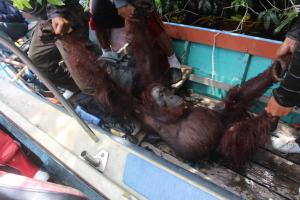Today is International Orangutan Day, a day to focus on the beauty and hardships the critically endangered species faces
As orangutans lose their habitat, human-orangutan conflict is an ongoing issue. However, conservationists are working hard to mitigate and problem solve.
SANTA MONICA, CALIFORNIA, USA, August 19, 2022 /EINPresswire.com/ -- Orangutans are found within the Indo-Malay archipelago on Borneo and Sumatra. Throughout these islands, there are three separate species of orangutan: the Bornean Orangutan (Pongo pygmaeus), Sumatran Orangutan (Pongo abelii), and Tapanuli orangutan (Pongo tapanuliensis). As a result of population decline, each orangutan species is classified as critically endangered under the International Union for Conservation of Nature (IUCN) Red List (IUCN, 2022). Many factors contribute to orangutan population declines, such as logging/deforestation, palm oil plantations (Voigt et al., 2018), and the illegal pet trade (Stiles et al., 2016). Human-orangutan conflict is another issue that can promote orangutan deaths and significantly impact orangutan population stability. Since human-orangutan conflict is a growing problem, it is crucial to know why it occurs and how to prevent it.Human-orangutan conflict develops due to interactions between humans and orangutans. To better describe these interactions, researchers have defined "conflict" as "a negative interaction involving actual or feared harm, damage or interference with activities" (Davis et al., 2013). Generally, the conflict between orangutans and humans is motivated by limited access to space and shared resources. However, other reasons can motivate conflict. For instance, a 2013 study interviewed villagers from 476 villages in Kalimantan (e.g., a region of Borneo) and found that the most common reason people reportedly shot an orangutan was fear or self-defense (Davis et al., 2013).
Furthermore, while orangutans are known to be seclusive in the rainforest, human-orangutan conflict has become more common with decreased habitat. Lack of habitat inevitably forces orangutans to journey out of the rainforest in search of food, where they may raid local's crop fields (Campbell-Smith et al., 2012). Ultimately, given the orangutan's extremely low annual reproductive rate (Utami-Atmoko et al., 2017), any increase in orangutan death rate is particularly impactful to orangutan recovery (Davis et al., 2013).
Conservationists continue studying methods that minimize human-orangutan conflict to combat orangutan deaths. For instance, covering crops with simplified tree nets (Campbell-Smith et al., 2012) and educating locals about how to respond to wild orangutans (Sherman et al., 2020) are feasible solutions that could save orangutans from death. Although to create effective management plans and encourage co-existence, it is critical to conduct follow-up research that provides insight into how these methods impact the lives of locals and orangutan population recovery (Davis et al., 2013). It is also essential to know that funding is going toward conservation strategies that work, and profitability analyses can only accomplish that by closely monitoring the overall efficiency of management plans. Recent research supported this idea by using cost-benefit analysis to show that protecting habitat, educating the public, and patrolling properties are orangutan conservation strategies that have presented the greatest return from investment over time (Santika et al., 2022). So, by monitoring the progress of a human-orangutan conflict mitigation plan, future researchers can discover the most cost-efficient and effective strategies for saving orangutans.
A notable strategy that conservation agencies may use to reduce human-orangutan conflict is orangutan translocation. Translocated wildlife are animals that are "intentionally captured from habitat patches and insecure situations for the purpose of releasing them into areas considered to be safe" (Sherman et al., 2020). Therefore, though this is not an end-all solution, orangutan translocation can be considered an option for saving orangutans involved in human-orangutan conflict scenarios. Generally, conservationists use translocation to prevent human-wildlife interactions, which may stem from various causes such as habitat loss or uncontrolled fires (Sherman et al., 2020). While orangutan translocation lacks conclusive data that supports its overall effectiveness as a conservation strategy (Sherman et al., 2020), translocation does provide immediate action to help animals forced into situations that will likely lead to more interactions with humans (Santika et al., 2022). For example, between 2007-2017, the highest rate of orangutan translocations occurred in 2015 after a series of forest fires in Kalimantan. These fires were determined to have minimized resource availability to an uninhabitable level, so orangutan translocations were performed as a last resort to save the orangutans in that region (Sherman et al., 2020). Therefore, in that situation, translocations were applied to prevent conflict between orangutans and nearby villages by moving orangutans to an adequate habitat and increasing their chances of surviving.
Orangutans are incredible animals, and everyone should be encouraged to look at ways to help all three species of orangutans. By supporting their conservation, orangutans can continue to be studied, and researchers can further develop management plans to stabilize orangutan populations. International Orangutan Day is an excellent opportunity to learn about orangutan population recovery and publicize orangutan conservation efforts. Furthermore, the international celebration falls on the same day as World Humanitarian Day! Thus, August 19th has become an eventful day where we can celebrate the magnificent orangutan and acknowledge the dedicated humanitarians who work to stabilize their existence.
----
References:
Campbell-Smith, G., Sembiring, R. and Linkie, M. (2012), Evaluating the effectiveness of human–orangutan conflict mitigation strategies in Sumatra. Journal of Applied Ecology, 49: 367-375. https://doi.org/10.1111/j.1365-2664.2012.02109.x
Davis, J.T., Mengersen, K., Abram, N.K., Ancrenaz, M., Wells, J.A., Meijaard, E. (2013) It’s Not Just Conflict That Motivates Killing of Orangutans. PLoS ONE 8(10): e75373. doi:10.1371/journal.pone.0075373.
IUCN. 2022. The IUCN Red List of Threatened Species. Version 2022-1. https://www.iucnredlist.org. Accessed on August, 15th 2022
Santika et al. (2022). Effectiveness of 20 years of conservation investments in protecting orangutans. Current Biology (32), pp. 1754–1763
Sherman, J., Ancrenaz, M., and Meijaard, E. (2020). Shifting apes: welfare and conservation outcomes of Bornean orangutan rescue and release in Kalimantan, Indonesia. J. Nat. Conserv. 55:125807. doi: 10.1016/j.jnc.2020.125807
Stiles, D., Redmond, I., Cress, D., Nellemann, C., and Formo, R.K. (2016). Stolen apes - the illicit trade in chimpanzees, gorillas, bonobos, and orang- utans. A rapid response assessment (United Nations Environment Programme, GRID-Arendal). http://www.grida.no.
Utami-Atmoko, S., Traylor-Holzer, K., Rifqi, M.A., Siregar, P.G., Achmad, B., Priadjati, A. (2019) Orangutan population and habitat viability assessment: Final report.
Voigt et al. (2018). Global Demand for Natural Resources Eliminated More Than 100,000 Bornean Orangutans. Current Biology (28), pp. 761–769.
Gary L Shapiro
Orang Utan Republik Foundation, Inc.
+1 310-401-6602
email us here
Visit us on social media:
Facebook
Twitter
LinkedIn
Legal Disclaimer:
EIN Presswire provides this news content "as is" without warranty of any kind. We do not accept any responsibility or liability for the accuracy, content, images, videos, licenses, completeness, legality, or reliability of the information contained in this article. If you have any complaints or copyright issues related to this article, kindly contact the author above.



